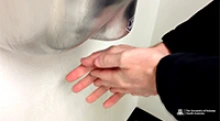Paper Towels vs. Air Hand Dryers: UArizona Health Sciences Researchers Evaluate Effectiveness of Both Hand-Drying Methods
A review of research studies on the hygienic benefits of hand-drying methods compared paper towels to electric warm-air hand dryers. The results found neither method has a clear hygienic advantage.
TUCSON, Ariz. – Numerous studies have outlined the benefits of electric warm air hand dryers, in comparison with paper towels, for drying hands after washing in public restrooms. The data, however, is conflicting and lacks key variables needed to assess human health risk, a University of Arizona Health Sciences research team concluded after reviewing nearly 300 papers and published studies on the topic.

Kelly R. Reynolds, MSPH, PhD, Mel and Enid Zuckerman College of Public Health research investigator at the University of Arizona. (Photo: University of Arizona Health Sciences)
“Conclusions that have been drawn and promoted to the public are from incomplete data or from studies that lack rigor or real-world scenarios,” said Kelly A. Reynolds, MSPH, PhD, director of the Environment, Exposure Science and Risk Assessment Center at the UArizona Mel and Enid Zuckerman College of Public Health. “We found that some study authors extended general recommendations without sufficient scientific evidence. The fact is, the breadth of available data does not favor one hand-drying method as more hygienic or safer than the other.”
See a video of Dr. Reynolds explaining the study’s findings.
To clarify if a particular hand-drying method is more hygienic, investigators conducted a comprehensive review of studies on hand-drying methods, relative to hygiene and health risks.
The research project, funded by Excel Dryer Inc., considered published scientific studies and “gray literature” on the topic. Gray literature includes unpublished or published research in non-commercial forms, such as government or academic reports, policy papers, white papers and other evaluations. Only 23 studies, about 8% of the total, met criteria for inclusion based on scientific rigor – a score determined by evaluating such factors as sample size, methodology, data quality and whether the study was conducted in a real-world setting.

A person using a warm-air electric hand dryer after washing their hands. (Photo: University of Arizona Health Sciences)
The final research project publication, “Comparison of Electric Hand Dryers and Paper Towels for Hand Hygiene: A Critical Review of the Literature,” evaluates an extensive range of previous research. The study was published in August in the Journal of Applied Microbiology.
The review undertook a broad analysis of a primary research question, “Are hand dryers more hygienic than paper towels?” A secondary question the team reviewed was, “Are paper towels safer than hand dryers, relative to human health risks?”
The results of the review? The collective data showed that neither hand drying method was more hygienic than the other.
The inconclusive results found in the current body of research, as well as a lack of data to support health claims, prevent specific policy or practice recommendations on hand-drying protocols.

A person using a paper towel to dry after washing their hands. (Photo: University of Arizona Health Sciences)
Dr. Reynolds noted that the most important thing to focus on in handwashing is technique – using soap, lathering all of the hands’ skin area, washing them for 20 to 30 seconds, and then drying the hands completely. That is the most effective way to prevent cross-contamination, whether you use an air dryer or a paper towel to dry your hands, she added.
A professor and chair of the Department of Community, Environment and Policy at the college, Dr. Reynolds co-authored the review study in collaboration with public health research colleagues Jonathan Sexton, PhD, Ashton Norman and Jean McClelland. Dr. Sexton is a senior research specialist in the department; Norman is a program coordinator for the Environment, Exposure Science and Risk Assessment Center; and McLelland is program director for community-based health information resources in the college’s Department of Health Promotion Sciences.
# # #
A video associated with this article appeared originally on the UArizona Health Sciences Connect website.
NOTE TO MEDIA WRITERS/EDITORS: Images and a video available at this link – https://arizona.box.com/s/3ot3lrwkdokjqgvw0pfyls6xzdbzmgxh.
About the University of Arizona Mel and Enid Zuckerman College of Public Health
Established in 2000, the Mel and Enid Zuckerman College of Public Health at the University of Arizona Health Sciences is the first nationally accredited college of public health in the Southwest. Today the college remains the only accredited college of public health in the state of Arizona, with campuses in Tucson and Phoenix. The college enrolls more than 1,100 students per year across degree programs at the bachelor's degree, master's degree and doctoral levels. Through research, education and community engagement, the UA Zuckerman College of Public Health continues to find solutions to public health problems in Arizona, the Southwest and globally. For more information: publichealth.arizona.edu (Follow us: Facebook | Twitter).
About the University of Arizona Health Sciences
The University of Arizona Health Sciences is the statewide leader in biomedical research and health professions training. UArizona Health Sciences includes the Colleges of Medicine (Tucson and Phoenix), Nursing, Pharmacy, and the Mel and Enid Zuckerman College of Public Health, with main campus locations in Tucson and the Phoenix Biomedical Campus in downtown Phoenix. From these vantage points, Health Sciences reaches across the state of Arizona, the greater Southwest and around the world to provide next-generation education, research and outreach. A major economic engine, Health Sciences employs nearly 5,000 people, has approximately 4,000 students and 900 faculty members, and garners $200 million in research grants and contracts annually. For more information: uahs.arizona.edu (Follow us: Facebook | Twitter | YouTube | LinkedIn | Instagram).

